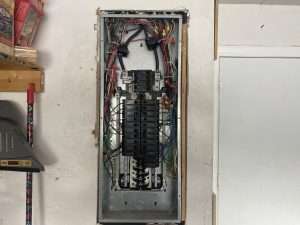No More False Alarms: How to Replace a Hardwired Smoke Detector

How to Replace a Hardwired Smoke Detector
- Turn off the power supply. Go to your electrical panel and locate the breaker for your smoke detectors. Turn off the power supply to the detectors by switching off the corresponding breaker.
- Remove the old smoke detector. Twist the smoke detector counterclockwise to release it from the mounting bracket. You should be able to gently pull it out of the bracket and disconnect the wires.
- Connect the wires to the new smoke detector. Connect the new smoke detector’s wires to the wires coming out of the wall or ceiling. Typically, the wires will be color-coded (black or red for hot, white for neutral, and green or bare copper for ground), but consult the manufacturer’s instructions to confirm which wires go where.
- Mount the new smoke detector. Line up the mounting bracket with the new smoke detector and twist it clockwise until it clicks into place. Make sure the detector is flush against the ceiling or wall.
- Turn on the power supply. Return to your electrical panel and turn on the breaker for your smoke detectors.
- Test the new smoke detector. Press the test button on the new detector to ensure it is working correctly. You may need to hold the button down for a few seconds for the alarm to sound.
- Check that all detectors are working. Walk around your home and test all the smoke detectors to make sure they are functioning correctly.
How Often Should You Check Your Smoke Detectors
Smoke detectors are a critical component of home safety, and it’s important to test them regularly to ensure they are working properly. Here are some general guidelines for testing smoke detectors:
- Test smoke detectors once a month: It’s a good idea to test your smoke detectors once a month to ensure that they are working correctly. Most smoke detectors have a “test” button that you can press to activate the alarm.
- Replace batteries once a year: If your smoke detectors are battery-powered, you should replace the batteries once a year. A good time to do this is when you adjust your clocks for daylight saving time.
- Replace smoke detectors every 10 years: Smoke detectors don’t last forever. Most manufacturers recommend replacing your smoke detectors every 10 years, even if they appear to be working fine.
- Test after renovations or changes to the home: If you’ve had any renovations or made changes to your home, it’s important to test your smoke detectors to ensure they are still functioning properly.
- Replace immediately if malfunctioning: If you test your smoke detector and it doesn’t work or if it’s making a chirping sound, replace it immediately. Don’t assume that the problem will go away on its own.
Where to Place Smoke Detectors In Your Home
Source: homeownerfaqs
Proper placement of smoke detectors is essential to ensuring that they can effectively detect smoke and provide early warning of potential fires. Here are some specific recommendations for where to place smoke detectors in your home:
- Bedrooms: It is recommended that you install smoke detectors in every bedroom or sleeping area. If a fire starts in a bedroom, a smoke detector will provide early warning to the occupants and give them more time to escape.
- Hallways: Smoke detectors should be installed in hallways outside of bedrooms and other sleeping areas. This provides early warning in case smoke enters the sleeping area from another part of the house.
- Living areas: Smoke detectors should be installed in living areas, such as the living room or family room. This can provide additional warning in case a fire starts in a living area.
- Kitchen: Smoke detectors should be installed in or near the kitchen, but not too close to cooking appliances. This is because cooking can often produce smoke or steam, which can set off a smoke detector.
- Basement: If you have a basement, you should install a smoke detector there as well. Fires can start anywhere in the home and can quickly spread to other levels.
- Interconnected smoke detectors: It is recommended that smoke detectors be interconnected so that when one detector sounds, all detectors in the home will sound. This ensures that everyone in the home can hear the alarm and evacuate quickly.
- Mounting height: Smoke detectors should be mounted on the ceiling or high on the wall, at least 4 inches away from the nearest wall. This allows smoke to easily reach the detector and trigger the alarm.
I hope this has been helpful. This article is only intended to be a guide and all electrical work should be conducted by a qualified professional. If you have additional questions and want to get in contact with GGR Home Inspections please send us a note, text, or call.






Pingback: Smoke Detectors Help to Keep You Safe 2022 – GGR Home Inspections